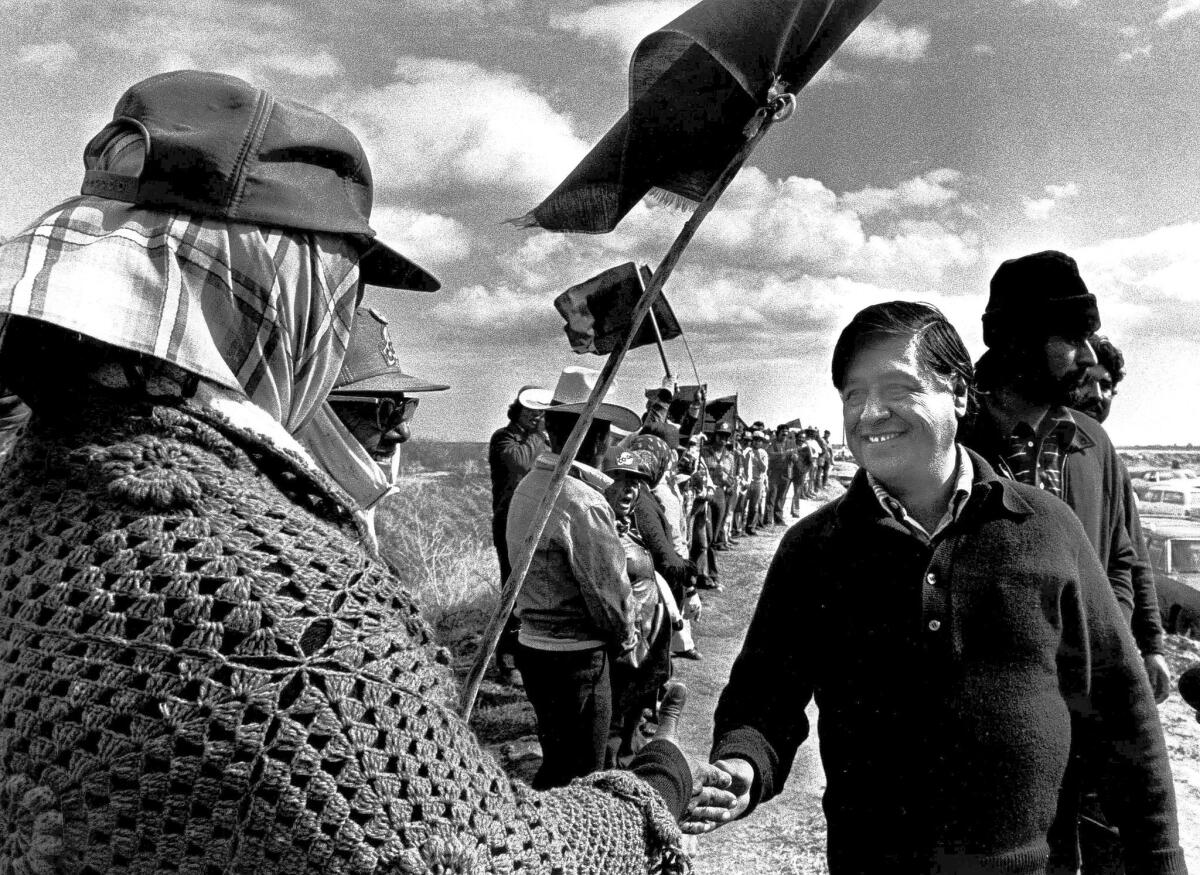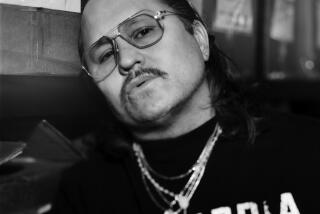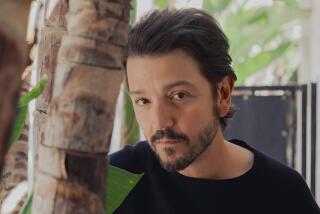Two versions of Cesar Chavez come to light in new film, book

At least 25 streets and 46 schools are named in his honor, but many young people know little about Cesar Chavez, who in life was a polarizing figure, most famous for the successful series of marches, fasts and strikes he led on behalf of mostly immigrant farmworkers.
The next big act of Chavez’s afterlife begins this month, with the first dramatic film about the towering Chicano figure and a major biography due out days before California and other states celebrate Cesar Chavez Day on March 31.
Both projects seek to reclaim Chavez’s place in the American memory. But the book and the movie offer markedly different portraits of a man who joined the pantheon of American civic saints after his death in 1993.
RELATED: ‘The Crusades of Cesar Chavez’ is a frank look at an imperfect leader
In the film “Cesar Chavez,” by a Mexican production team led by the actor-director Diego Luna, he is a heroic and beatific figure using nonviolence to lead his people to victory. The movie ends with Chavez’s United Farm Workers winning contracts in 1970 from recalcitrant growers.
The 534-page book, “The Crusades of Cesar Chavez,” by former Times editor and reporter Miriam Pawel, follows Chavez, from his birth in a Depression-era Arizona and his father’s loss of the family farm, to his death, following a long period in which the UFW was in decline. Much of the second half of the book delves deeply into what Chavez’s old allies call “the dark side” — his isolation and his embrace of what some saw as a cult of personality.
For Luna, the movie has been a four-year crusade, working largely outside the Hollywood studio system.
“We’re lucky [Hollywood] didn’t say yes,” Luna said in an interview.
Hollywood executives suggested Luna cast one of two bankable Spanish heartthrobs, Antonio Banderas or Javier Bardem, as the lead. Instead he gave the role to Michael Peña. Like many talented Mexican American actors, Peña’s has a resume filled with mostly small roles, including as a faux Arab sheik in “American Hustle.”
BEST MOVIES OF 2013: Turan | Sharkey | Olsen
Luna and his production company Canana (which he co-founded with actor Gael Garcia Bernal) have been screening the film for select, often largely Latino audiences across the U.S. ahead of its March 28 release date. On Wednesday, he also screened it at the White House for President Obama.
Luna and producer Pablo Cruz were also recently at UCLA, at a standing-room-only event for more than 300 people, sponsored by the university’s Chicano Studies faculty and students. “Please help us spread the word,” Luna told the audience. “We have to send a message to the industry that our stories have to be represented. And with the depth and the complexity they deserve.”
“We found the right partners for the film,” Luna said. Mexican investors put up much of the funding. The $10-million film, shot in Sonora, Mexico, is being distributed by Participant Media and Lionsgate, and is opening in about 600 theaters.
Chavez declined offers to have dramatic films made about him during his lifetime, and since his death he has appeared on the big screen mostly in documentaries.
PHOTOS: Box office top 10 of 2013 | Biggest Box Office Flops of 2013
Luna made Chavez’s family life the emotional center of his story. He said he ignored another executive who asked, “How can you make this more sexy?” “I said that this is beyond sexy,” Luna said. “It’s not even just the story of Cesar Chavez. It’s the story of a movement.”
“Cesar Chavez” is filled with authentic visual details, including the religious iconography that was a staple of UFW events and the infamous “short hoes” that ravaged the bodies of farmworkers forced to use them. America Ferrera plays Cesar’s wife, Helen, with Rosario Dawson as union leader Dolores Huerta and Jack Holmes as ally Robert F. Kennedy. At 101 minutes, the film limits itself to a decade in Chavez’s life.
The book, published by Bloomsbury Press, is the first full-scale biography. “I’m writing beyond the hagiography,” Pawel said. “It does him a disservice to portray him in a more simplistic way.”
Chavez earned his saintly hue by going on a 25-day fast in 1968 that helped turned public opinion in the UFW’s favor, an event that’s key in Luna’s film. But Pawel said the film only fleetingly captures the real Chavez’s genius for strategy and tactics. He could also be gruff leader who gave no quarter to perceived enemies, a quality he readily acknowledged.
CRITICS’ PICKS: What to watch, where to go, what to eat
“There is a big difference between being a saint and being an angel,” he told a reporter in an interview quoted in Pawel’s book. “Saints are known for being tough and stubborn.”
Pawel made ample use of archival sources, including Chavez’s papers, which he donated to Wayne State University in Detroit. She also listened to hundreds of tapes of interviews and UFW board meetings. The early tapes capture his “lyricism” and idealism, she said. But later tapes record the ethnic slur he used in the 1970s to refer to undocumented immigrants he considered to be strikebreakers.
The sharply different perspectives reflect how the film and book were made. Canana held the Chavez family’s film rights, and the family met extensively with Luna and his cast. But author Pawel is persona non grata to Chavez’s descendants, largely because she wrote a 2006 series in The Times that portrayed the modern-day UFW as an organization that does little to improve the lot of farmworkers.
“The family wouldn’t talk to me, but I knew that going in,” Pawel said. Only one family member responded to her emails: Fernando, Chavez’s oldest son, whose conflicts with his father are portrayed in the film. But Pawel said he too declined to talk to her.
PHOTOS: Celebrities by The Times
Fernando, now a lawyer, is at the center of the movie because of a story Helen Chavez shared with the cast before shooting began. “She said that at one point, Fernando left the family,” Luna said. His conflicts with his famous father were just too much to bear.
For Luna, a native of Mexico, the story was a reminder of what led him to Chavez. Not long ago, his second child was born — in the United States. Luna, who has homes in Mexico City and Los Angeles, wanted to be able to tell his Mexican American son more about the man revered as a pioneer of Chicano history.
“This is a movie about a father and son, and about how hard it is for a son to understand what his father needs to do,” said Luna, a former child actor and star of “Y Tu Mamá También.”
There’s an air of earnestness about Luna’s film. After it screened in Berlin, reviews suggested that he was too respectful and thus drained his protagonist of complexity. “Cesar Chavez” has also earned mixed reviews from those who worked with Chavez.
PHOTOS: Billion-dollar movie club
Current UFW President Arturo Rodriguez praised the film. But Marshall Ganz, one of Chavez’s closest aides, called it “a cartoon of the man and his leadership.” Although the movie often depicts Chavez alone, he “could not allow himself to be alone,” Ganz said in an interview. Nor was Chavez likely to do something he does in the film — begin shouting at a picket line.
“His charisma was a kind of counter-charisma,” Ganz said. “His leadership was built around his capacity to build relationships... He connected people to each other.”
Still, Ganz said he hopes the film will stimulate new interest in Chavez, and lead people to read Pawel’s book and the growing body of scholarship about the farmworker movement. That scholarship includes the work of Yale professor Stephen Pitti and Arizona State’s Matthew Garcia, whose own book “From the Jaws of Victory” focused on how the movement changed after the UFW’s great triumphs.
“He’s a man who’s been characterized as an ‘American Gandhi,’ but he was also a union man,” Garcia said. “The union world is rough and tumble.” In the 1980s, Chavez purged perceived enemies and “Communists,” and in his final years he isolated himself at his home in the Tehachapi Mountains. “It was his Lear period,” Garcia said.
PHOTOS: Behind the scenes of movies and TV
Garcia hopes that renewed interest in Chavez will lead students to explore Latino history and discover leaders whose names are not as widely known, including the late activists Bert Corona and Luisa Moreno, both of whom were pioneers of the immigrant rights movement.
But “Cesar Chavez” the film seems destined to have an effect, especially among those yearning for courageous role models. Chavez has long been just a name on a street sign to many students, or a chapter in a school textbook. “Cesar Chavez” gives them a flesh-and-blood person.
At one screening this month at the Robert F. Kennedy Community Schools in central Los Angeles, hundreds of students erupted into a rhythmic, united clap as the film’s final credits rolled.
“We don’t have to do big things to make ourselves leaders,” said student Jaewoong Lee during a post-screening discussion. “We have to unselfishly spend a little time for a cause and that’s what is going to make us into a greater individual that contributes to society.”
Times staff writer Stephen Caesar contributed to this report.
More to Read
Only good movies
Get the Indie Focus newsletter, Mark Olsen's weekly guide to the world of cinema.
You may occasionally receive promotional content from the Los Angeles Times.











